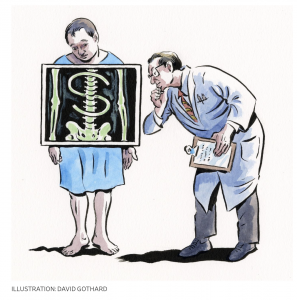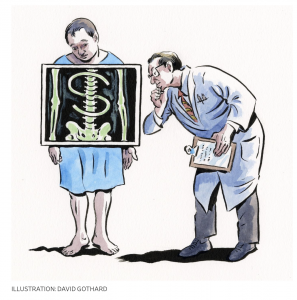In Part I of this series, we learned that there is a new cancer screening test that has shown the ability to detect cancers earlier than possible before, which has led to more effective treatment. Roger Royse, a lawyer in California, had the test which detected early pancreatic cancer, which is usually detected late when it is routinely fatal. But because his cancer was detected early, he had successful treatment and is now cancer free.
Allysia Finley, writing in The Wall Street Journal, tells us this happy ending was only made possible, however, because Mr. Royse was willing to pay for the test out of his own pocket, because insurance wouldn’t pay for it. Which leads to the obvious question, why not?
The test is relatively expensive at $949, but this is cheap compared to other tests that are routinely done, like MRI scans, which usually cost thousands. The test, called Galleri, is produced by a company called Grail.
Grail’s test has a roughly 0.5% false-positive rate, meaning 1 in 200 patients who don’t have cancer will get a positive signal. Its positive predictive value is 43%, so that of every 100 patients with a positive signal, 43 actually have cancer. That may sound low, but the positive predictive value for some recommended cancer screenings is far lower. Fewer than 1 in 10 women with an abnormal finding on a mammogram are diagnosed with breast cancer.
Because Grail uses machine learning to detect DNA-methylation cancer linkages, the Grail test’s accuracy should improve as more tests and patient data are collected. Dr. Ofman says the company also aims to reduce the test’s cost by scaling up manufacturing and detecting cancers with less genetic sequencing.
But therein lies a chicken-and-egg problem. Patient access is limited by Galleri’s lack of Food and Drug Administration approval and insurance coverage. These could help reduce the test’s costs and improve its accuracy. But regulators may balk at approving the test, and insurers at covering it, until it becomes cheaper and more reliable.
Regulators classify Galleri as a lab-developed test. Such tests are overseen by the Centers for Medicare and Medicaid Services and can be prescribed without FDA approval. This regulatory pathway allows hospitals, research centers and startups to develop tests without running the FDA’s bureaucratic gantlet. Since diagnostic tests can’t injure patients, no safety review is necessary.
The FDA in October proposed regulating lab-developed tests as medical devices, which generally require agency approval. That could severely curtail patient access and slow test development since the FDA doesn’t have the personnel to evaluate the tens of thousands of lab-developed tests on the market. The rule’s public comment period closed on Dec. 4.
Finley says, “Requiring randomized controlled trials and FDA approval for multicancer early-detection tests could restrict access for years. Hundreds of thousands of patients would likely have to be enrolled in trials, some receiving the test with the others in a control group. They would have to be followed over many years to determine whether patients who received the test were diagnosed with specific cancers earlier than those in the control group and how much longer they lived as a result. Proving a statistically significant benefit could take a decade or longer.”
One alternative is to rely on real-world studies, which Grail is already doing. One study of patients 50 and older without signs of cancer showed that the test doubled the number of cancers detected. The FDA could also approve the test, and CMS could provide Medicare coverage, on the condition that providers collect patient data that can be used to analyze the benefits.
Dana Goldman, the University of Southern California’s dean of public policy, likes that idea: “There will be a lot of suffering if we have to wait 10 years for the tests to be approved.” Mr. Goldman has spent decades studying the economics of medical treatments. One recurring problem he has seen: “Epidemiologists are always getting cancer wrong,” he says. “Epidemiologists a decade ago said U.S. overtreats cancers. Well, no, the EU undertreats cancer.”
A 2012 study that he co-authored found that the higher U.S. spending on cancer care relative to Europe between 1983 and 1999 resulted in significantly higher survival rates for American patients than for those in Europe. By his study’s calculation, U.S. spending on cancer treatments during that period resulted in $556 billion in net benefits owing to reduced mortality.
He expects Galleri and other multicancer early-detection tests to reduce deaths and produce public-health and economic benefits that exceed their monetary costs. Cancers caught early are cheaper to treat—less likely to require a cocktail of expensive therapies, and in some cases removable without the need for chemotherapy.
Let’s hope this test is approved by private insurance and Medicare soon. We need all the early detection cancer screening tests we can get!




